Legal Aspects of Responsible Leadership: Case Study Analysis 102SAM
VerifiedAdded on 2022/11/19
|8
|2440
|230
Case Study
AI Summary
This assignment analyzes a case study involving the legal aspects of responsible leadership, specifically focusing on a scenario where a florist supplied flowers containing toxic substances to Beyonce. The analysis examines the florist's responsibilities under the tort of negligence, evaluating the duty of care using the Caparo test, breach of duty, causation, and damages. It explores the remedies available to Beyonce, including compensation for physical harm and economic losses. Furthermore, the assignment considers alternative dispute resolution methods, such as arbitration, to avoid court involvement. The conclusions drawn emphasize the florist's breach of duty and the potential for Beyonce to claim damages, recommending arbitration as a viable solution. The assignment references relevant legal principles and case laws, such as Donoghue v Stevenson, to support the arguments presented.
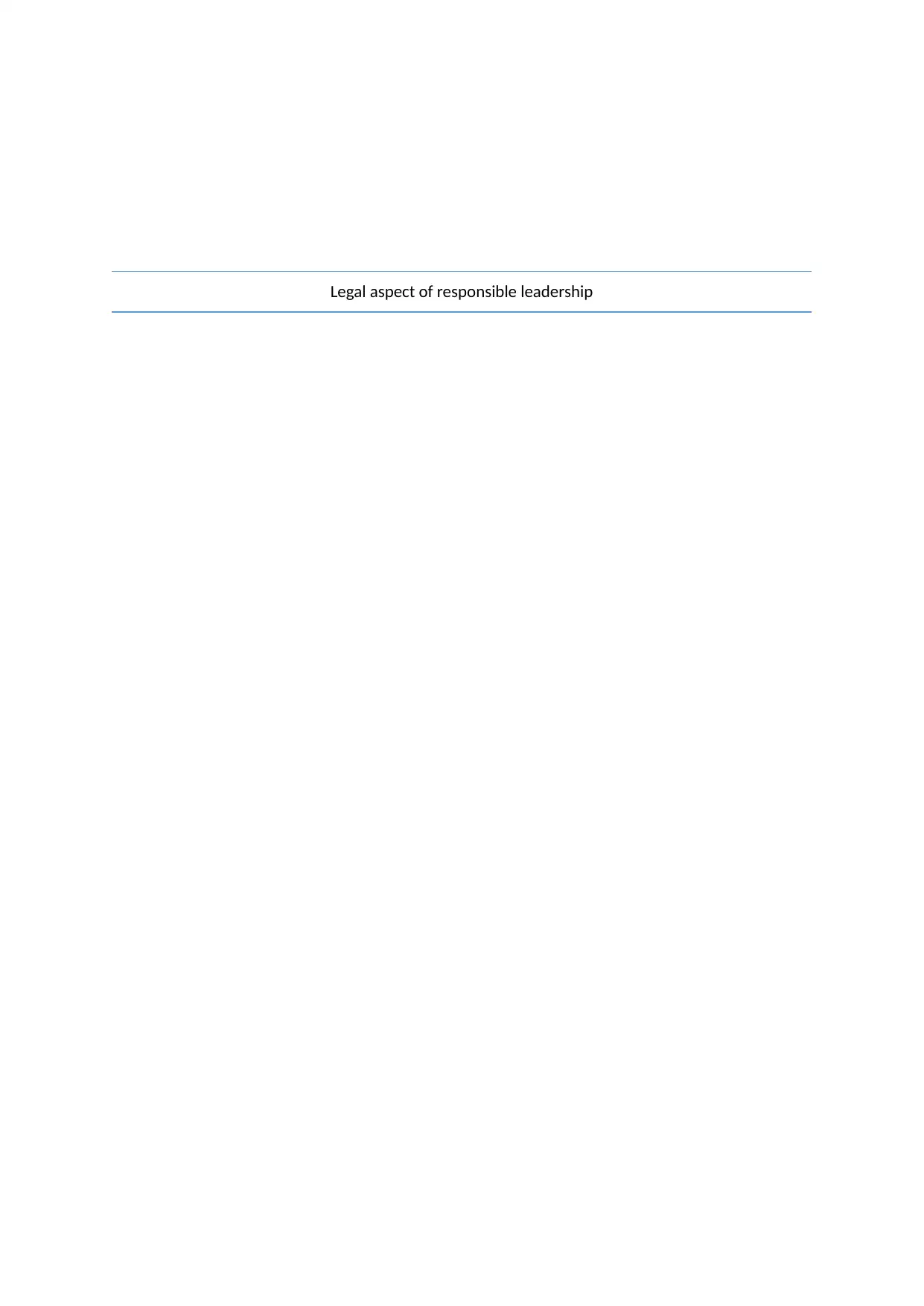
Legal aspect of responsible leadership
Paraphrase This Document
Need a fresh take? Get an instant paraphrase of this document with our AI Paraphraser
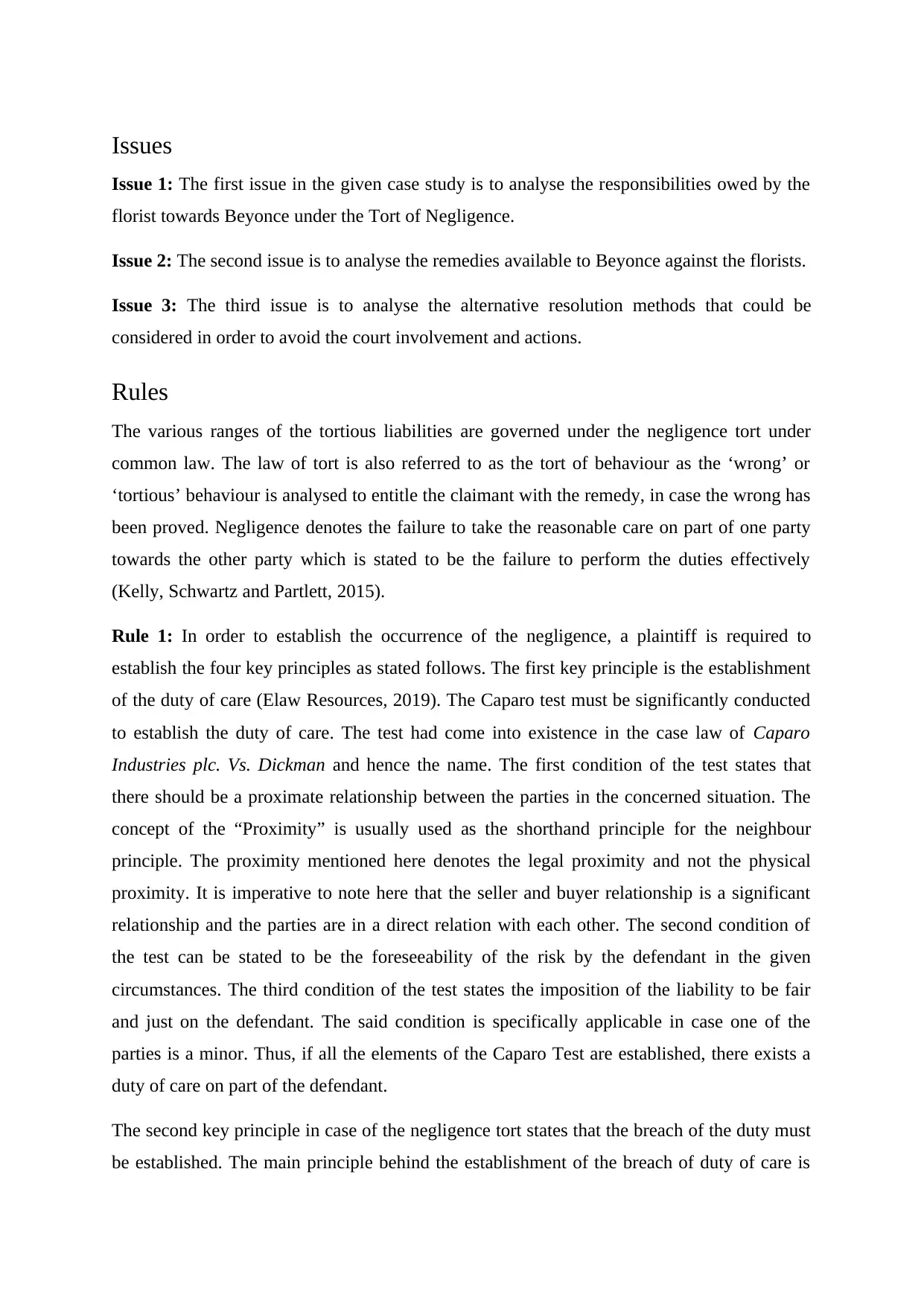
Issues
Issue 1: The first issue in the given case study is to analyse the responsibilities owed by the
florist towards Beyonce under the Tort of Negligence.
Issue 2: The second issue is to analyse the remedies available to Beyonce against the florists.
Issue 3: The third issue is to analyse the alternative resolution methods that could be
considered in order to avoid the court involvement and actions.
Rules
The various ranges of the tortious liabilities are governed under the negligence tort under
common law. The law of tort is also referred to as the tort of behaviour as the ‘wrong’ or
‘tortious’ behaviour is analysed to entitle the claimant with the remedy, in case the wrong has
been proved. Negligence denotes the failure to take the reasonable care on part of one party
towards the other party which is stated to be the failure to perform the duties effectively
(Kelly, Schwartz and Partlett, 2015).
Rule 1: In order to establish the occurrence of the negligence, a plaintiff is required to
establish the four key principles as stated follows. The first key principle is the establishment
of the duty of care (Elaw Resources, 2019). The Caparo test must be significantly conducted
to establish the duty of care. The test had come into existence in the case law of Caparo
Industries plc. Vs. Dickman and hence the name. The first condition of the test states that
there should be a proximate relationship between the parties in the concerned situation. The
concept of the “Proximity” is usually used as the shorthand principle for the neighbour
principle. The proximity mentioned here denotes the legal proximity and not the physical
proximity. It is imperative to note here that the seller and buyer relationship is a significant
relationship and the parties are in a direct relation with each other. The second condition of
the test can be stated to be the foreseeability of the risk by the defendant in the given
circumstances. The third condition of the test states the imposition of the liability to be fair
and just on the defendant. The said condition is specifically applicable in case one of the
parties is a minor. Thus, if all the elements of the Caparo Test are established, there exists a
duty of care on part of the defendant.
The second key principle in case of the negligence tort states that the breach of the duty must
be established. The main principle behind the establishment of the breach of duty of care is
Issue 1: The first issue in the given case study is to analyse the responsibilities owed by the
florist towards Beyonce under the Tort of Negligence.
Issue 2: The second issue is to analyse the remedies available to Beyonce against the florists.
Issue 3: The third issue is to analyse the alternative resolution methods that could be
considered in order to avoid the court involvement and actions.
Rules
The various ranges of the tortious liabilities are governed under the negligence tort under
common law. The law of tort is also referred to as the tort of behaviour as the ‘wrong’ or
‘tortious’ behaviour is analysed to entitle the claimant with the remedy, in case the wrong has
been proved. Negligence denotes the failure to take the reasonable care on part of one party
towards the other party which is stated to be the failure to perform the duties effectively
(Kelly, Schwartz and Partlett, 2015).
Rule 1: In order to establish the occurrence of the negligence, a plaintiff is required to
establish the four key principles as stated follows. The first key principle is the establishment
of the duty of care (Elaw Resources, 2019). The Caparo test must be significantly conducted
to establish the duty of care. The test had come into existence in the case law of Caparo
Industries plc. Vs. Dickman and hence the name. The first condition of the test states that
there should be a proximate relationship between the parties in the concerned situation. The
concept of the “Proximity” is usually used as the shorthand principle for the neighbour
principle. The proximity mentioned here denotes the legal proximity and not the physical
proximity. It is imperative to note here that the seller and buyer relationship is a significant
relationship and the parties are in a direct relation with each other. The second condition of
the test can be stated to be the foreseeability of the risk by the defendant in the given
circumstances. The third condition of the test states the imposition of the liability to be fair
and just on the defendant. The said condition is specifically applicable in case one of the
parties is a minor. Thus, if all the elements of the Caparo Test are established, there exists a
duty of care on part of the defendant.
The second key principle in case of the negligence tort states that the breach of the duty must
be established. The main principle behind the establishment of the breach of duty of care is
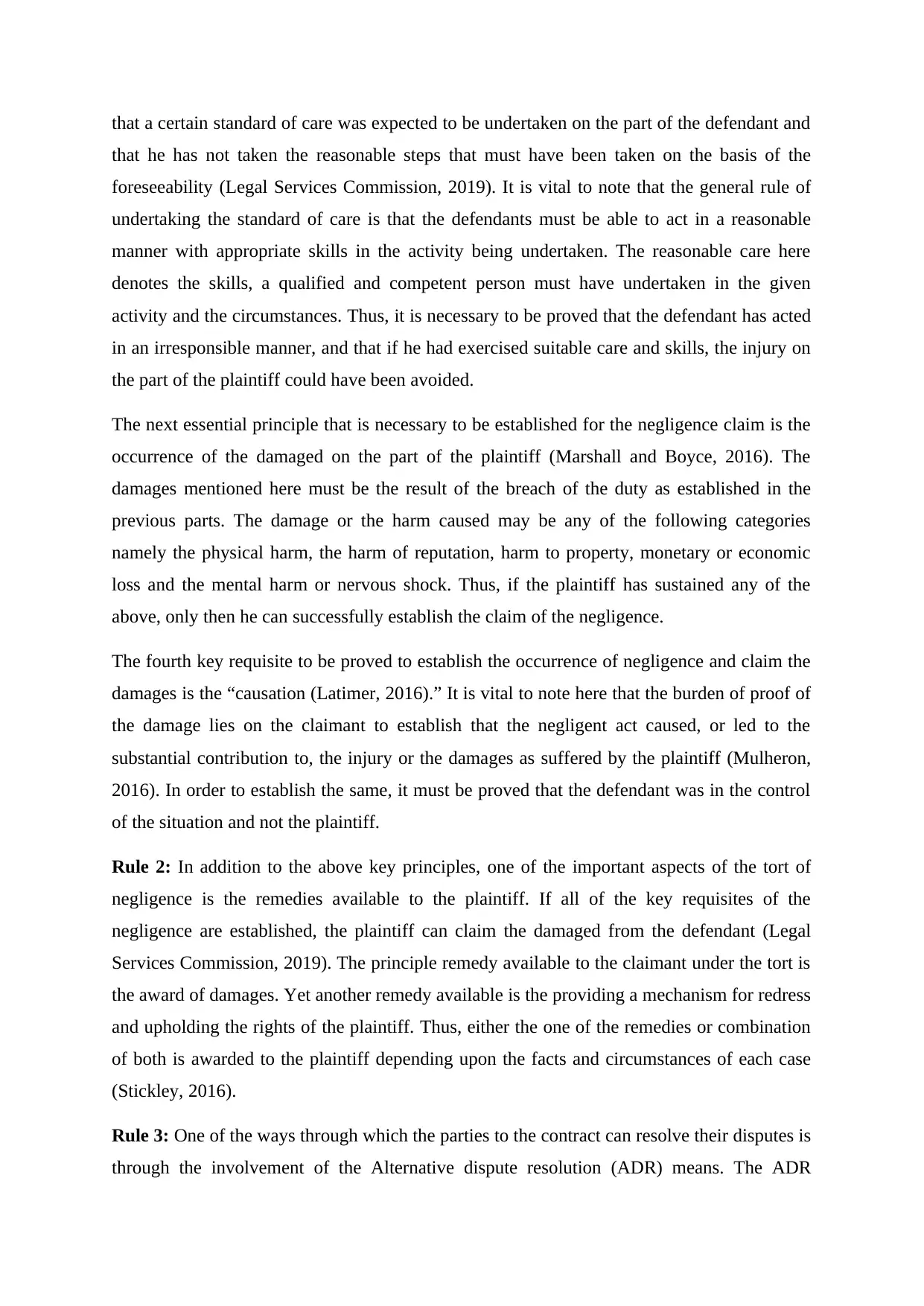
that a certain standard of care was expected to be undertaken on the part of the defendant and
that he has not taken the reasonable steps that must have been taken on the basis of the
foreseeability (Legal Services Commission, 2019). It is vital to note that the general rule of
undertaking the standard of care is that the defendants must be able to act in a reasonable
manner with appropriate skills in the activity being undertaken. The reasonable care here
denotes the skills, a qualified and competent person must have undertaken in the given
activity and the circumstances. Thus, it is necessary to be proved that the defendant has acted
in an irresponsible manner, and that if he had exercised suitable care and skills, the injury on
the part of the plaintiff could have been avoided.
The next essential principle that is necessary to be established for the negligence claim is the
occurrence of the damaged on the part of the plaintiff (Marshall and Boyce, 2016). The
damages mentioned here must be the result of the breach of the duty as established in the
previous parts. The damage or the harm caused may be any of the following categories
namely the physical harm, the harm of reputation, harm to property, monetary or economic
loss and the mental harm or nervous shock. Thus, if the plaintiff has sustained any of the
above, only then he can successfully establish the claim of the negligence.
The fourth key requisite to be proved to establish the occurrence of negligence and claim the
damages is the “causation (Latimer, 2016).” It is vital to note here that the burden of proof of
the damage lies on the claimant to establish that the negligent act caused, or led to the
substantial contribution to, the injury or the damages as suffered by the plaintiff (Mulheron,
2016). In order to establish the same, it must be proved that the defendant was in the control
of the situation and not the plaintiff.
Rule 2: In addition to the above key principles, one of the important aspects of the tort of
negligence is the remedies available to the plaintiff. If all of the key requisites of the
negligence are established, the plaintiff can claim the damaged from the defendant (Legal
Services Commission, 2019). The principle remedy available to the claimant under the tort is
the award of damages. Yet another remedy available is the providing a mechanism for redress
and upholding the rights of the plaintiff. Thus, either the one of the remedies or combination
of both is awarded to the plaintiff depending upon the facts and circumstances of each case
(Stickley, 2016).
Rule 3: One of the ways through which the parties to the contract can resolve their disputes is
through the involvement of the Alternative dispute resolution (ADR) means. The ADR
that he has not taken the reasonable steps that must have been taken on the basis of the
foreseeability (Legal Services Commission, 2019). It is vital to note that the general rule of
undertaking the standard of care is that the defendants must be able to act in a reasonable
manner with appropriate skills in the activity being undertaken. The reasonable care here
denotes the skills, a qualified and competent person must have undertaken in the given
activity and the circumstances. Thus, it is necessary to be proved that the defendant has acted
in an irresponsible manner, and that if he had exercised suitable care and skills, the injury on
the part of the plaintiff could have been avoided.
The next essential principle that is necessary to be established for the negligence claim is the
occurrence of the damaged on the part of the plaintiff (Marshall and Boyce, 2016). The
damages mentioned here must be the result of the breach of the duty as established in the
previous parts. The damage or the harm caused may be any of the following categories
namely the physical harm, the harm of reputation, harm to property, monetary or economic
loss and the mental harm or nervous shock. Thus, if the plaintiff has sustained any of the
above, only then he can successfully establish the claim of the negligence.
The fourth key requisite to be proved to establish the occurrence of negligence and claim the
damages is the “causation (Latimer, 2016).” It is vital to note here that the burden of proof of
the damage lies on the claimant to establish that the negligent act caused, or led to the
substantial contribution to, the injury or the damages as suffered by the plaintiff (Mulheron,
2016). In order to establish the same, it must be proved that the defendant was in the control
of the situation and not the plaintiff.
Rule 2: In addition to the above key principles, one of the important aspects of the tort of
negligence is the remedies available to the plaintiff. If all of the key requisites of the
negligence are established, the plaintiff can claim the damaged from the defendant (Legal
Services Commission, 2019). The principle remedy available to the claimant under the tort is
the award of damages. Yet another remedy available is the providing a mechanism for redress
and upholding the rights of the plaintiff. Thus, either the one of the remedies or combination
of both is awarded to the plaintiff depending upon the facts and circumstances of each case
(Stickley, 2016).
Rule 3: One of the ways through which the parties to the contract can resolve their disputes is
through the involvement of the Alternative dispute resolution (ADR) means. The ADR
⊘ This is a preview!⊘
Do you want full access?
Subscribe today to unlock all pages.

Trusted by 1+ million students worldwide

denotes the ways of resolving disputes between consumers and traders where the court
actions are not involved. The various forms of ADRs available are the mediation and
arbitration (Department of Business Innovation and Skills, 2015). The Arbitration Act 1996 is
the chief regulatory act for the arbitration proceedings in England, Wales and Northern
Ireland (Johnson, 2018). It is vital to note that the process of arbitration is run as a tribunal.
The process generally involves a single arbitrator or a panel of three arbitrators. The decision
for the procedural and evidential matters are done by the arbitrators. These proceedings are
usually shorter and less complicate and formal as compared to the court litigations. A firm
decision on a case is reached by the arbitrators, based on the evidence presented by the
parties and the hearing conducted. It is essential to note that the pre-condition for the means
of arbitration is the agreement of both the process as the said process is voluntary.
Applications
Application 1: In the given case study, it must be noted that the florist has included the white
bell shaped flowers called “Lily of the Valley” without the knowledge that the same contain
dangerous toxins. According to the Caparo test, the florists being the seller is in a legal
proximity with the customers. It is imperative to note that though Beyonce did not buy the
flowers from the florists directly, still as per the application of the principle stated in the case
law of the Donoghue vs. Stevenson, there is a legal proximity. Further, there exists
foreseeability of the risks on the part of florists, the reason being the activity is directly
related to his business and thus, the florists is expected to be aware of the products he is
dealing in. The above principles establish the duty of care on the part of the florists to be
aware of the potential harmful effects of the flowers he is dealing in as part of his business
activities.
The second key principle as stated in the previous parts is the establishment of the breach. In
the given case study, it has been stated that the florists is not aware of the toxic substances in
the flowers he is dealing in which is supplied to Simone. As a result of the said toxic supply,
the health is affected. As a general rule of standard of care, a reasonable businessman should
possess the knowledge of the products dealt as part of the business activity together with the
potential harmful effects associated with the same. The flowers supplied as part of the
bouquet did not only contain the harmful toxins but also were capable of slowing down the
heart rate which can lead to a very fatal condition on the users of such flower. Had the
actions are not involved. The various forms of ADRs available are the mediation and
arbitration (Department of Business Innovation and Skills, 2015). The Arbitration Act 1996 is
the chief regulatory act for the arbitration proceedings in England, Wales and Northern
Ireland (Johnson, 2018). It is vital to note that the process of arbitration is run as a tribunal.
The process generally involves a single arbitrator or a panel of three arbitrators. The decision
for the procedural and evidential matters are done by the arbitrators. These proceedings are
usually shorter and less complicate and formal as compared to the court litigations. A firm
decision on a case is reached by the arbitrators, based on the evidence presented by the
parties and the hearing conducted. It is essential to note that the pre-condition for the means
of arbitration is the agreement of both the process as the said process is voluntary.
Applications
Application 1: In the given case study, it must be noted that the florist has included the white
bell shaped flowers called “Lily of the Valley” without the knowledge that the same contain
dangerous toxins. According to the Caparo test, the florists being the seller is in a legal
proximity with the customers. It is imperative to note that though Beyonce did not buy the
flowers from the florists directly, still as per the application of the principle stated in the case
law of the Donoghue vs. Stevenson, there is a legal proximity. Further, there exists
foreseeability of the risks on the part of florists, the reason being the activity is directly
related to his business and thus, the florists is expected to be aware of the products he is
dealing in. The above principles establish the duty of care on the part of the florists to be
aware of the potential harmful effects of the flowers he is dealing in as part of his business
activities.
The second key principle as stated in the previous parts is the establishment of the breach. In
the given case study, it has been stated that the florists is not aware of the toxic substances in
the flowers he is dealing in which is supplied to Simone. As a result of the said toxic supply,
the health is affected. As a general rule of standard of care, a reasonable businessman should
possess the knowledge of the products dealt as part of the business activity together with the
potential harmful effects associated with the same. The flowers supplied as part of the
bouquet did not only contain the harmful toxins but also were capable of slowing down the
heart rate which can lead to a very fatal condition on the users of such flower. Had the
Paraphrase This Document
Need a fresh take? Get an instant paraphrase of this document with our AI Paraphraser
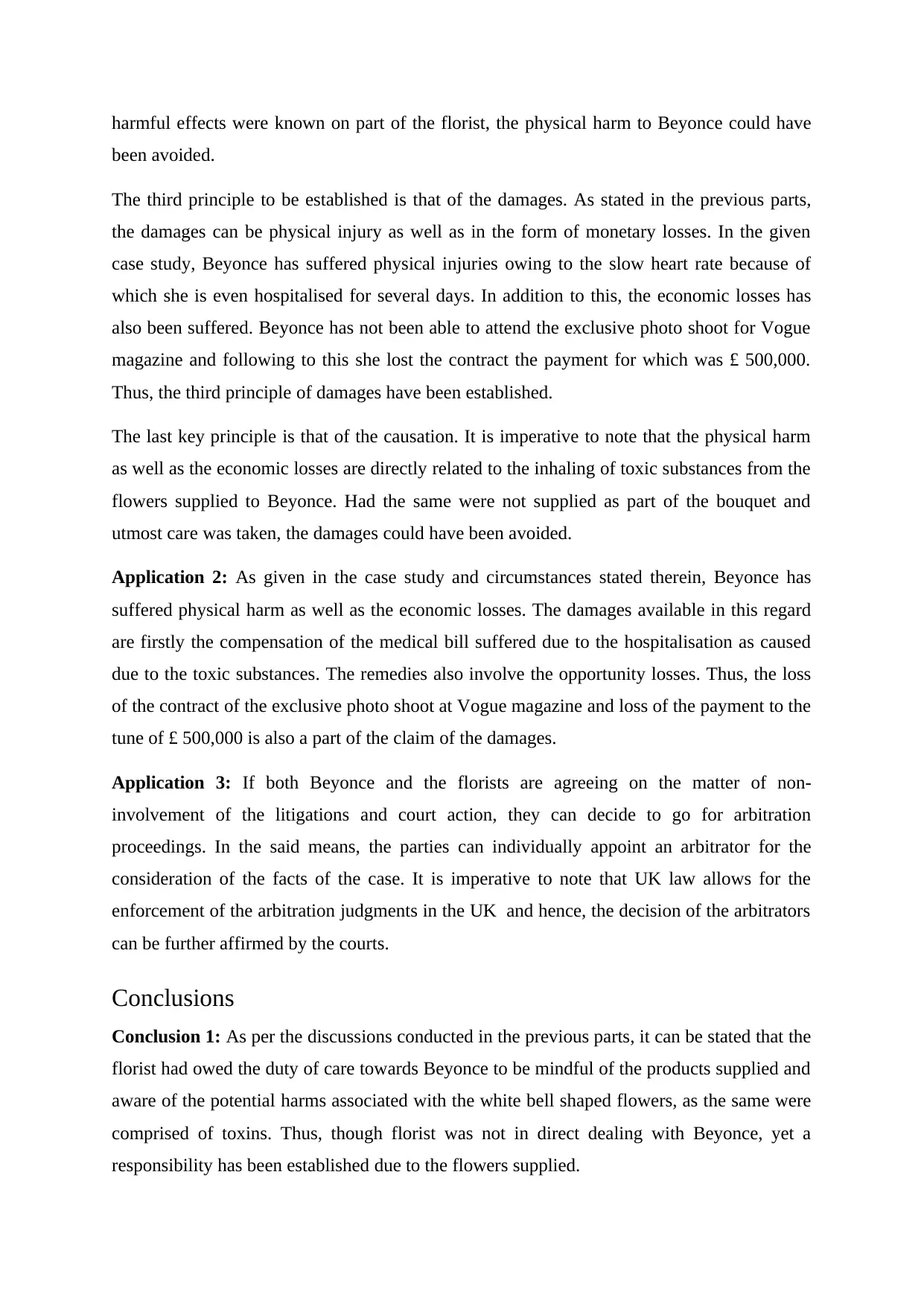
harmful effects were known on part of the florist, the physical harm to Beyonce could have
been avoided.
The third principle to be established is that of the damages. As stated in the previous parts,
the damages can be physical injury as well as in the form of monetary losses. In the given
case study, Beyonce has suffered physical injuries owing to the slow heart rate because of
which she is even hospitalised for several days. In addition to this, the economic losses has
also been suffered. Beyonce has not been able to attend the exclusive photo shoot for Vogue
magazine and following to this she lost the contract the payment for which was £ 500,000.
Thus, the third principle of damages have been established.
The last key principle is that of the causation. It is imperative to note that the physical harm
as well as the economic losses are directly related to the inhaling of toxic substances from the
flowers supplied to Beyonce. Had the same were not supplied as part of the bouquet and
utmost care was taken, the damages could have been avoided.
Application 2: As given in the case study and circumstances stated therein, Beyonce has
suffered physical harm as well as the economic losses. The damages available in this regard
are firstly the compensation of the medical bill suffered due to the hospitalisation as caused
due to the toxic substances. The remedies also involve the opportunity losses. Thus, the loss
of the contract of the exclusive photo shoot at Vogue magazine and loss of the payment to the
tune of £ 500,000 is also a part of the claim of the damages.
Application 3: If both Beyonce and the florists are agreeing on the matter of non-
involvement of the litigations and court action, they can decide to go for arbitration
proceedings. In the said means, the parties can individually appoint an arbitrator for the
consideration of the facts of the case. It is imperative to note that UK law allows for the
enforcement of the arbitration judgments in the UK and hence, the decision of the arbitrators
can be further affirmed by the courts.
Conclusions
Conclusion 1: As per the discussions conducted in the previous parts, it can be stated that the
florist had owed the duty of care towards Beyonce to be mindful of the products supplied and
aware of the potential harms associated with the white bell shaped flowers, as the same were
comprised of toxins. Thus, though florist was not in direct dealing with Beyonce, yet a
responsibility has been established due to the flowers supplied.
been avoided.
The third principle to be established is that of the damages. As stated in the previous parts,
the damages can be physical injury as well as in the form of monetary losses. In the given
case study, Beyonce has suffered physical injuries owing to the slow heart rate because of
which she is even hospitalised for several days. In addition to this, the economic losses has
also been suffered. Beyonce has not been able to attend the exclusive photo shoot for Vogue
magazine and following to this she lost the contract the payment for which was £ 500,000.
Thus, the third principle of damages have been established.
The last key principle is that of the causation. It is imperative to note that the physical harm
as well as the economic losses are directly related to the inhaling of toxic substances from the
flowers supplied to Beyonce. Had the same were not supplied as part of the bouquet and
utmost care was taken, the damages could have been avoided.
Application 2: As given in the case study and circumstances stated therein, Beyonce has
suffered physical harm as well as the economic losses. The damages available in this regard
are firstly the compensation of the medical bill suffered due to the hospitalisation as caused
due to the toxic substances. The remedies also involve the opportunity losses. Thus, the loss
of the contract of the exclusive photo shoot at Vogue magazine and loss of the payment to the
tune of £ 500,000 is also a part of the claim of the damages.
Application 3: If both Beyonce and the florists are agreeing on the matter of non-
involvement of the litigations and court action, they can decide to go for arbitration
proceedings. In the said means, the parties can individually appoint an arbitrator for the
consideration of the facts of the case. It is imperative to note that UK law allows for the
enforcement of the arbitration judgments in the UK and hence, the decision of the arbitrators
can be further affirmed by the courts.
Conclusions
Conclusion 1: As per the discussions conducted in the previous parts, it can be stated that the
florist had owed the duty of care towards Beyonce to be mindful of the products supplied and
aware of the potential harms associated with the white bell shaped flowers, as the same were
comprised of toxins. Thus, though florist was not in direct dealing with Beyonce, yet a
responsibility has been established due to the flowers supplied.
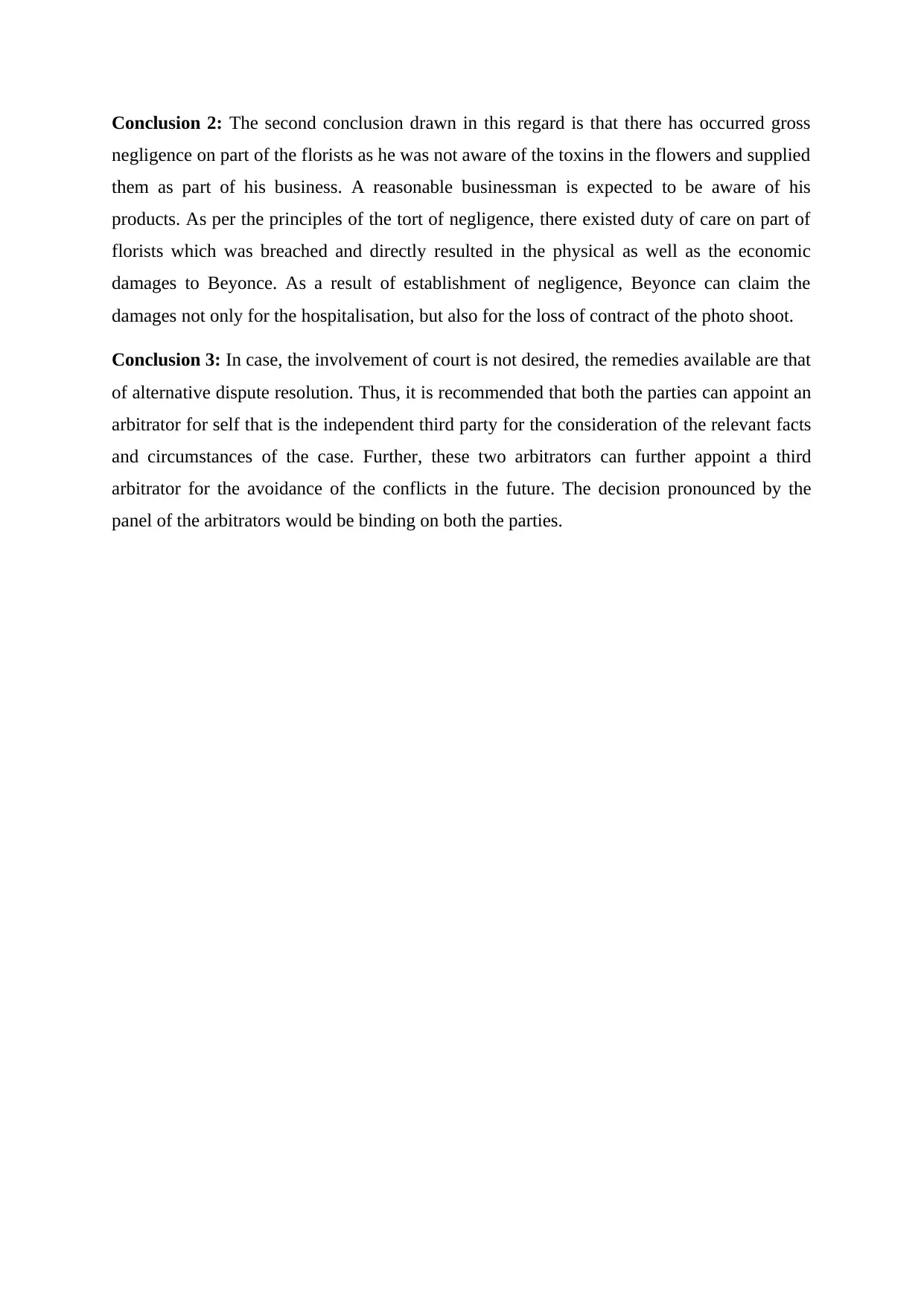
Conclusion 2: The second conclusion drawn in this regard is that there has occurred gross
negligence on part of the florists as he was not aware of the toxins in the flowers and supplied
them as part of his business. A reasonable businessman is expected to be aware of his
products. As per the principles of the tort of negligence, there existed duty of care on part of
florists which was breached and directly resulted in the physical as well as the economic
damages to Beyonce. As a result of establishment of negligence, Beyonce can claim the
damages not only for the hospitalisation, but also for the loss of contract of the photo shoot.
Conclusion 3: In case, the involvement of court is not desired, the remedies available are that
of alternative dispute resolution. Thus, it is recommended that both the parties can appoint an
arbitrator for self that is the independent third party for the consideration of the relevant facts
and circumstances of the case. Further, these two arbitrators can further appoint a third
arbitrator for the avoidance of the conflicts in the future. The decision pronounced by the
panel of the arbitrators would be binding on both the parties.
negligence on part of the florists as he was not aware of the toxins in the flowers and supplied
them as part of his business. A reasonable businessman is expected to be aware of his
products. As per the principles of the tort of negligence, there existed duty of care on part of
florists which was breached and directly resulted in the physical as well as the economic
damages to Beyonce. As a result of establishment of negligence, Beyonce can claim the
damages not only for the hospitalisation, but also for the loss of contract of the photo shoot.
Conclusion 3: In case, the involvement of court is not desired, the remedies available are that
of alternative dispute resolution. Thus, it is recommended that both the parties can appoint an
arbitrator for self that is the independent third party for the consideration of the relevant facts
and circumstances of the case. Further, these two arbitrators can further appoint a third
arbitrator for the avoidance of the conflicts in the future. The decision pronounced by the
panel of the arbitrators would be binding on both the parties.
⊘ This is a preview!⊘
Do you want full access?
Subscribe today to unlock all pages.

Trusted by 1+ million students worldwide
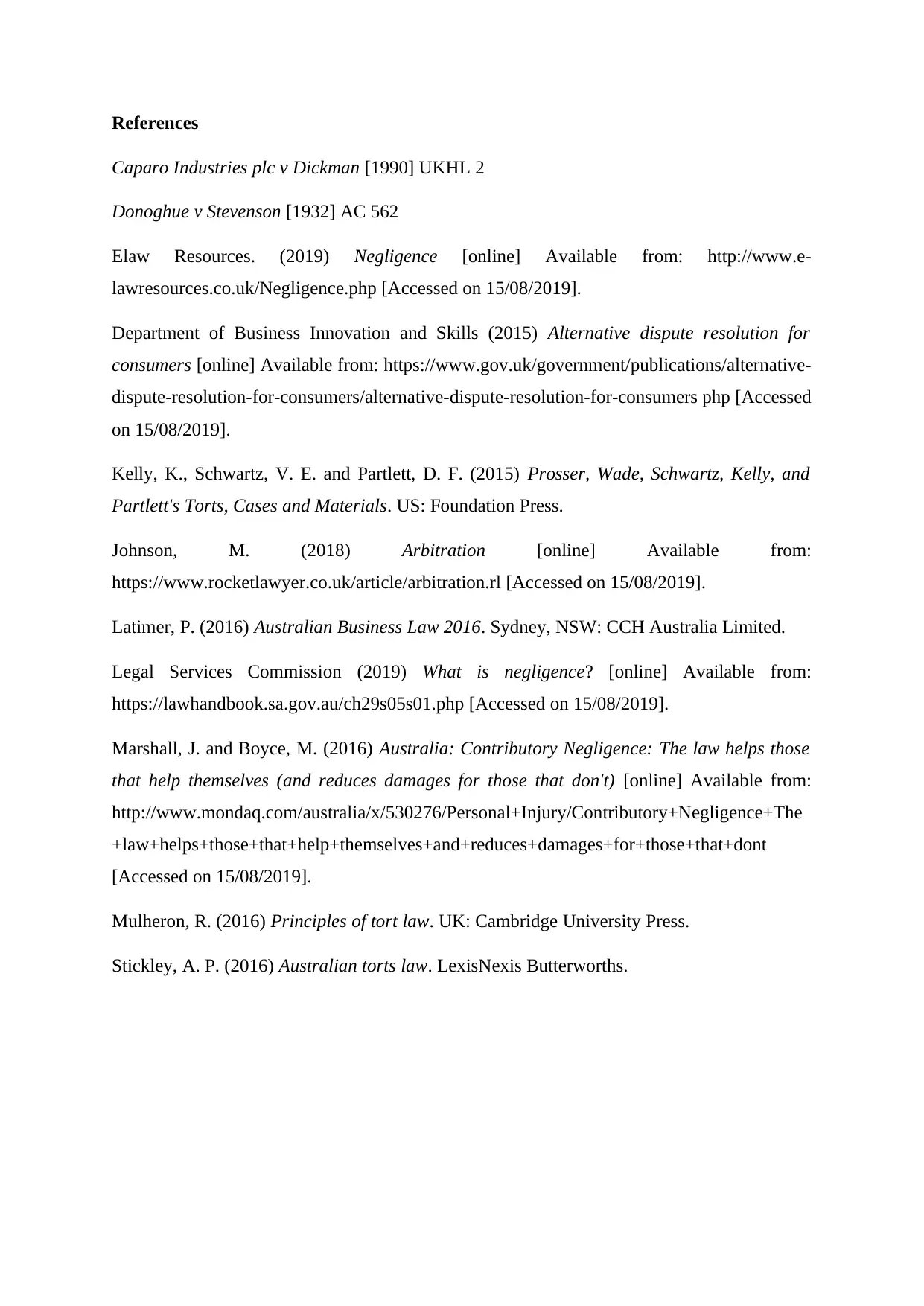
References
Caparo Industries plc v Dickman [1990] UKHL 2
Donoghue v Stevenson [1932] AC 562
Elaw Resources. (2019) Negligence [online] Available from: http://www.e-
lawresources.co.uk/Negligence.php [Accessed on 15/08/2019].
Department of Business Innovation and Skills (2015) Alternative dispute resolution for
consumers [online] Available from: https://www.gov.uk/government/publications/alternative-
dispute-resolution-for-consumers/alternative-dispute-resolution-for-consumers php [Accessed
on 15/08/2019].
Kelly, K., Schwartz, V. E. and Partlett, D. F. (2015) Prosser, Wade, Schwartz, Kelly, and
Partlett's Torts, Cases and Materials. US: Foundation Press.
Johnson, M. (2018) Arbitration [online] Available from:
https://www.rocketlawyer.co.uk/article/arbitration.rl [Accessed on 15/08/2019].
Latimer, P. (2016) Australian Business Law 2016. Sydney, NSW: CCH Australia Limited.
Legal Services Commission (2019) What is negligence? [online] Available from:
https://lawhandbook.sa.gov.au/ch29s05s01.php [Accessed on 15/08/2019].
Marshall, J. and Boyce, M. (2016) Australia: Contributory Negligence: The law helps those
that help themselves (and reduces damages for those that don't) [online] Available from:
http://www.mondaq.com/australia/x/530276/Personal+Injury/Contributory+Negligence+The
+law+helps+those+that+help+themselves+and+reduces+damages+for+those+that+dont
[Accessed on 15/08/2019].
Mulheron, R. (2016) Principles of tort law. UK: Cambridge University Press.
Stickley, A. P. (2016) Australian torts law. LexisNexis Butterworths.
Caparo Industries plc v Dickman [1990] UKHL 2
Donoghue v Stevenson [1932] AC 562
Elaw Resources. (2019) Negligence [online] Available from: http://www.e-
lawresources.co.uk/Negligence.php [Accessed on 15/08/2019].
Department of Business Innovation and Skills (2015) Alternative dispute resolution for
consumers [online] Available from: https://www.gov.uk/government/publications/alternative-
dispute-resolution-for-consumers/alternative-dispute-resolution-for-consumers php [Accessed
on 15/08/2019].
Kelly, K., Schwartz, V. E. and Partlett, D. F. (2015) Prosser, Wade, Schwartz, Kelly, and
Partlett's Torts, Cases and Materials. US: Foundation Press.
Johnson, M. (2018) Arbitration [online] Available from:
https://www.rocketlawyer.co.uk/article/arbitration.rl [Accessed on 15/08/2019].
Latimer, P. (2016) Australian Business Law 2016. Sydney, NSW: CCH Australia Limited.
Legal Services Commission (2019) What is negligence? [online] Available from:
https://lawhandbook.sa.gov.au/ch29s05s01.php [Accessed on 15/08/2019].
Marshall, J. and Boyce, M. (2016) Australia: Contributory Negligence: The law helps those
that help themselves (and reduces damages for those that don't) [online] Available from:
http://www.mondaq.com/australia/x/530276/Personal+Injury/Contributory+Negligence+The
+law+helps+those+that+help+themselves+and+reduces+damages+for+those+that+dont
[Accessed on 15/08/2019].
Mulheron, R. (2016) Principles of tort law. UK: Cambridge University Press.
Stickley, A. P. (2016) Australian torts law. LexisNexis Butterworths.
Paraphrase This Document
Need a fresh take? Get an instant paraphrase of this document with our AI Paraphraser

1 out of 8
Related Documents
Your All-in-One AI-Powered Toolkit for Academic Success.
+13062052269
info@desklib.com
Available 24*7 on WhatsApp / Email
![[object Object]](/_next/static/media/star-bottom.7253800d.svg)
Unlock your academic potential
Copyright © 2020–2025 A2Z Services. All Rights Reserved. Developed and managed by ZUCOL.





